Monitoring of meteorology at Turkey Lakes watershed
Precipitation, surface and ground waters
Systematic collection of physical data and water samples for chemical analysis occurs year-round in the TLW. The information derived from this monitoring activity is an important component of almost all TLW projects, whether short or long term. In particular, it is essential for determining terrestrial and lake mass budgets, and evaluating within- and between-year variability, seasonal cycles and multi-year trends. Information collected on a routine or nearly routine basis by the TLW Study (plus a contact person) is listed below, but note that individual researchers often collect extra samples or perform additional measurements to address specific project needs. Several examples of the monitoring data are presented in the Site informationsection.
Meteorology
- Ten minute averages of air temperature, wind speed, wind direction, relative humidity and barometric pressure. Short-wave, long-wave, UV-a and UV-b radiation are measured every 0.5 seconds. All variables are measured at the primary "met" site just outside the watershed boundary which is co-located with the CAPMoN precipitation monitoring station. Daily values or statistics (e.g. minimum, maximum and mean temperature) are computed and stored in a database. Learn more
- Contact: Dean Jeffries.
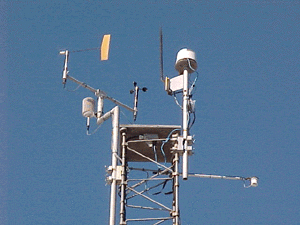
Long Description
Met Sensors at Turkey Lakes Watershed. Daily values or statistics (e.g. minimum, maximum and mean temperature) are computed and stored in a database.
Precipitation
- Daily precipitation quantity; daily wet deposition of H+, most major ions (including NH4+ and NO3- ); daily air concentrations of particulates (once again most major ions including NH4+ and NO3-) and gaseous HNO3 and SO2; and continuous ground level ozone. All are measured at the Algoma CAPMoNstation. Contact: David MacTavish.
- Weekly precipitation quantity both at the primary "met" site as well as at 5 sites within the watershed. Weekly bulk deposition of H+, major ions, nutrients and some metals is measured at the "met" site to estimate total input of variables not covered by CAPMoN. Contact: Dean Jeffries.
- Monthly wet deposition of major ions, nutrients and some metals has been measured at the primary "met" site as part of a Great Lakes precipitation monitoring network.
- Weekly snowpack water equivalent is measured at the "met" site and 12 other sites within the watershed throughout the snow accumulation and ablation period. Snowpack chemistry is measured weekly at the "met" site and monthly at the other sites; during the melt period snow sampling occurs more frequently. Contact: Dean Jeffries.
- Discontinuous measurement of throughfall and stemflow volume and chemistry has been made at several sites within the watershed. Contact: Paul Hazlett.
- Wet deposition of organic contaminants has been measured at the "met" site by several programs and individuals. Sampling frequency varies between programs. Contact: *Bill Strachan (* contact D. S. Jeffries for correspondence).
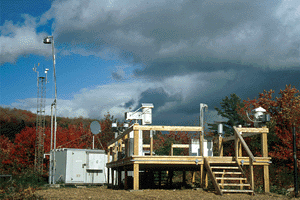
CAPMoN Site at Turkey Lakes Watershed
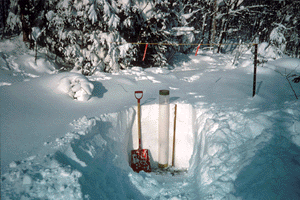
Snow Sampling at Turkey Lakes Watershed
Streams
- Continuous, year-round measurement of stream stage that is later converted to flow using a stage-discharge relationship occurs on 13 streams draining terrestrial, headwater basins (Contact: Paul Hazlett) and at/near the lake outflows and 2 other stations along the principal watershed tributary, Norberg Creek (Contact: Dean Jeffries). Daily flow values are stored in the database.
- Samples are collected at flow gauging stations to quantify stream chemistry (major ions, nutrients, DOC and some metals). Sampling frequency varies according to flow, being as seldom as bi-weekly during winter low flow and as frequent as daily during spring melt high flows. Contact for headwater streams: Paul Hazlett. Contact for lake outflows and Norberg Creek: Dean Jeffries.
- Learn more.
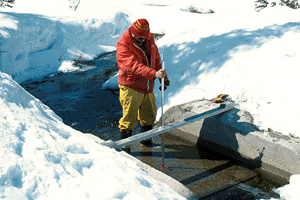
Stream Gauging at Turkey Lakes Watershed
Lakes
- The thermal structure and dissolved O2 profile of all 4 lakes is determined monthly during the period of ice cover and bi-weekly during the ice-free season. Contact: Dean Jeffries.
- Determination of lake chemistry (major ions, nutrients, DOC and some metals) involves collection of whole-lake, volume-weighted samples throughout the year with the same frequency as the measurement of thermal structure. When a lake is thermally stratified, volume-weighted epilimnion, metalimnion and hypolimnion samples are collected in addition to the whole-lake sample. Epi-, meta- and hypolimnion boundaries are established at the time of sampling from the thermal profile. On some occasions in early years of the TLW Study, discreet chemical sampling of the lake profile at 1 m intervals was performed instead of the volume-weighted sampling. This still occurs monthly for Little Turkey Lake only. Contact: Dean Jeffries.
- Learn more.
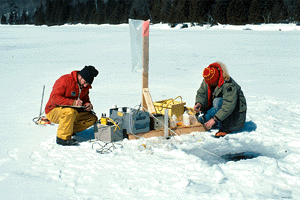
Lake Sampling at Turkey Lakes Watershed
Ground waters
- Many zero-tension lysimeters have been deployed at several locations to collect water percolating through the forest floor and near-surface soil horizons. Soil waters from horizons <1 m deep are sampled using porous cup lysimeters. Sampling frequency is irregular depending on water flux, and major ions, nutrients and some metals are normally quantified. Contact: Paul Hazlett.
- Water at >1 m depth within the till is sampled from 65 piezometer wells at least once each year after spring runoff is over (May). Some sampling sites are a multi-level nest of piezometer wells. Contact: Dean Jeffries.
- Learn more.
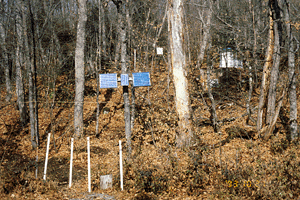
Ground Water Sampling at Turkey Lakes Watershed